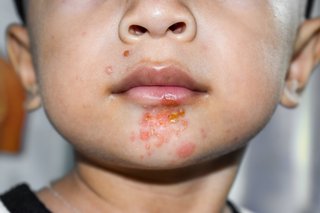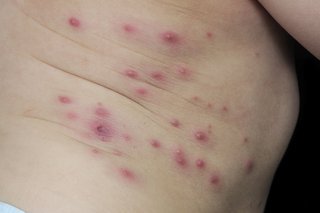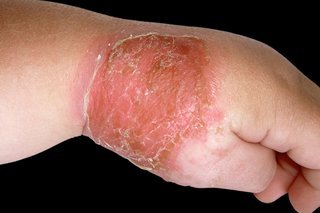Impetigo is a skin infection that's very contagious but not usually serious. It is caused by bacteria.
It usually gets better in 7 to 10 days if you get treatment or 2 to 3 weeks without treatment.
Anyone can get it, but it's very common in young children.
Check if you or your child has impetigo
Impetigo starts with red sores or blisters. The redness may be harder to see on brown and black skin.
The sores or blisters can start anywhere. But they usually start on exposed areas like your face and hands or around your tummy. When they burst, they leave crusty, golden-brown patches.
These patches can:
- look a bit like cornflakes stuck to your skin
- get bigger
- spread to other parts of your body
- be itchy
- sometimes be painful



Non-urgent advice: Speak to a GP if you or your child:
- might have impetigo
- had treatment for impetigo but the symptoms change or get worse
- had impetigo before and it keeps coming back
Impetigo is very infectious. Check with your GP before you go to them.
A GP will check to make sure it's not something more serious, like cellulitis.
Treatment for impetigo
If you have impetigo, your GP can prescribe an antibiotic cream to speed up your recovery. They may prescribe antibiotic tablets if it has spread a lot.
Do not stop using the antibiotic cream or tablets early, even if the impetigo starts to clear up.
If impetigo keeps coming back
A GP can take a swab from around your nose to check for the bacteria that causes impetigo.
They might prescribe an antiseptic that you put in your nose. This is to try to clear the bacteria and stop the impetigo coming back.
How to stop impetigo spreading or getting worse
Impetigo can spread to other parts of your body or to other people until it stops being contagious.
It stops being contagious:
- 48 hours after you start using the treatment your GP prescribed
- when the patches dry out and crust over - if you do not get treatment
To help stop impetigo spreading or getting worse while it's contagious:
Do
-
stay at home
-
keep sores, blisters and crusty patches clean and dry
-
cover them with loose clothing or gauze bandages
-
wash your hands frequently
-
wash your face cloths, sheets and towels at a high temperature
-
wash or wipe down toys with soap and warm water if your children have impetigo
Don't
-
do not touch or scratch sores, blisters or crusty patches - this also helps stop scarring
-
do not have close contact with children, or people with diabetes or a weakened immune system
-
do not share face cloths, sheets or towels
-
do not prepare food for other people
-
do not go to the gym
-
do not play contact sports
How to avoid getting impetigo
Impetigo usually infects skin that's already damaged.
Avoid infection by:
- keeping cuts, scratches and insect bites clean by washing with warm water and soap
- getting treatment for skin conditions, like eczema
